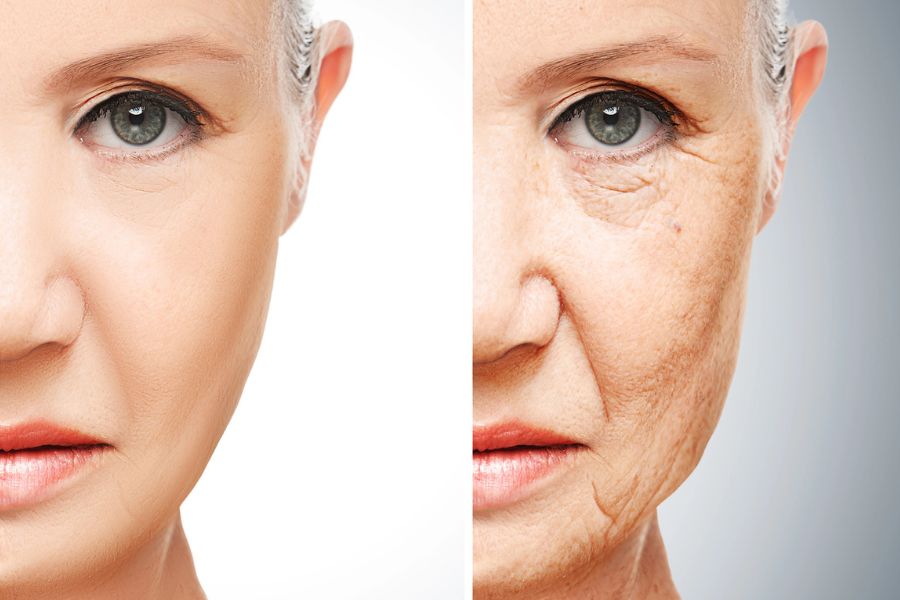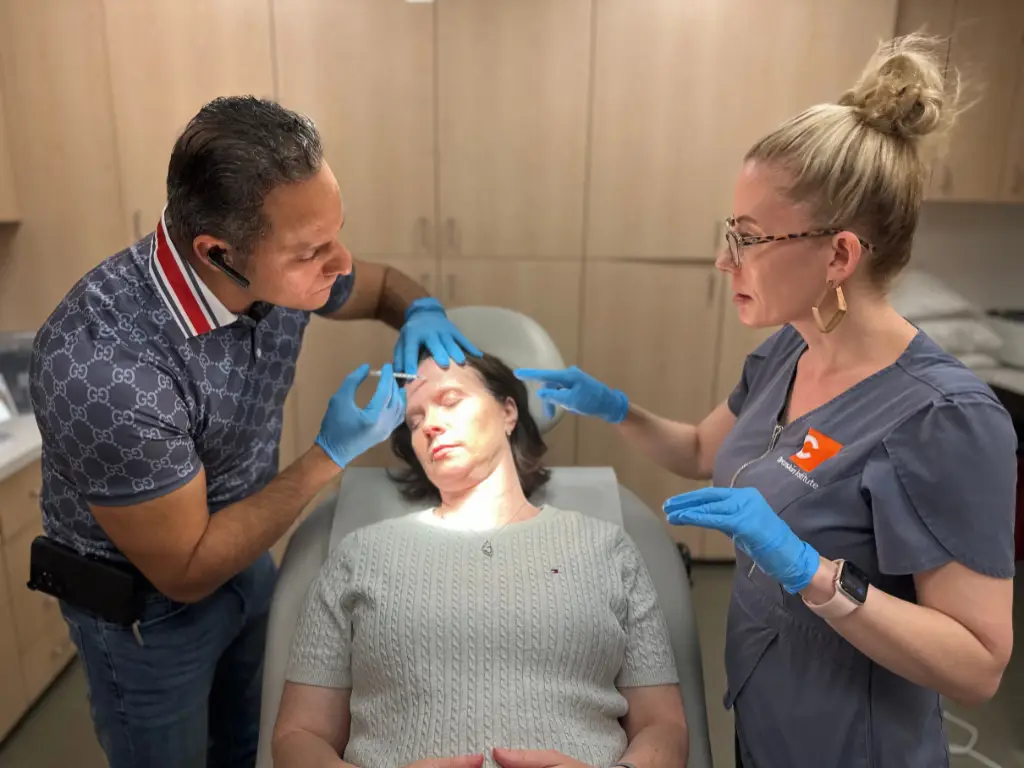Celebrating 20 Years of Training in Botox®, Aesthetic Medicine
and Medical Weight Management
Days
Hours
Minutes
Save 25% on Hands-on Botox® Training
All 2026 dates on sale. Register before December 31!
All 2026 dates on sale. Register before December 31!
“Ozempic® face” refers to the common side effects of the diabetes drug called Ozempic®. These side effects can make the skin on your face appear older and saggy.
What causes this and what can you do to avoid these negative side effects from this extremely popular medication.

Ozempic® face is a term often used to refer to a potential side effect of the medication Ozempic®, wherein users may experience changes in their facial skin condition or appearance.
Ozempic®, generically known as semaglutide, is a medication used to manage type 2 diabetes. It is an injectable drug that helps to regulate blood sugar levels by mimicking the action of a hormone in the body that causes the pancreas to release insulin. Apart from regulating blood glucose levels, Ozempic® may also contribute to weight loss.
Facial changes or reactions related to Ozempic® can manifest in different ways among different users. Some may experience acne, rashes, or urticaria, while others might notice changes in facial skin texture, such as increased dryness or oiliness. However, this side effect is considered rare, with the majority of people who use Ozempic® not experiencing any facial changes.
Despite the potential for facial changes, Ozempic® remains a commonly prescribed medication for managing blood sugar levels in type 2 diabetes patients. The likelihood of experiencing ‘Ozempic® face’ is small when compared to the potential benefits of the medication for the overall health and well-being of diabetes patients.
Even so, like any medication, using Ozempic® is not without risk. It’s important for individuals using Ozempic® to monitor any changes in their overall health or appearance, including on their faces.
If you’re an Ozempic® user and you notice any significant changes in your facial skin condition, do not hesitate to consult with your healthcare provider. While it’s usually not a cause for serious concern, a ‘reaction’ on your face could indicate that your body is reacting to the medication in an unexpected or undesirable way.
To properly manage reactions to Ozempic®, healthcare providers may suggest changes in skincare routine, medications, or in some cases, may change or adjust the treatment plan to better control the side effects.
In summary, ‘Ozempic® face’ refers to potential facial changes that may arise as a side effect of using Ozempic®, including outbreaks of acne, rashes, changes in skin texture, or other skin conditions. While it’s a rare reaction, users of Ozempic® should always consult with their healthcare provider if such changes occur.
The occurrence of ‘Ozempic® face’ as a side effect of the drug Ozempic® is relatively rare.
There’s no specific statistic indicating just how common these facial changes are among Ozempic® users, in part because this side effect can vary greatly among different individuals. Some users may not experience any change in their facial appearance at all, while others may notice mild to moderate symptoms.
The manufacturer of Ozempic®, Novo Nordisk, reports that the most common side effects of Ozempic® include nausea, vomiting, diarrhea, abdominal pain, and constipation. Meanwhile, changes in skin condition, which may contribute to the so-called ‘Ozempic® face,’ are not listed among the most common side effects.
A study published in the Journal of Clinical Endocrinology and Metabolism noted that skin reactions were reported in fewer than 10% of patients who received Ozempic®. These skin reactions, which can include changes in facial skin condition, are considered less common than gastrointestinal side effects.
Given that the incidence of ‘Ozempic® face’ is low, it may not be a significant concern for most patients considering or already using Ozempic®. Regardless, anyone using the medication should monitor their health and appearance closely and report any changes to their healthcare provider.
‘Serious’ skin reactions, which might include severe rashes, hives, or other visually notable changes, are even more rare with the use of Ozempic®. In many cases, these reactions might be indicative of an allergic response to the medication, which would necessitate immediate medical attention and possibly cessation of the drug.
While the potential for ‘Ozempic® face’ exists, it’s important to weigh this potential against the proven benefits of the drug in managing type 2 diabetes. With careful monitoring and regular communication with healthcare providers, patients can successfully navigate any side effects that may occur while using Ozempic®.
As always, patients should keep a balanced perspective when considering side effects of any medication. What matters most is finding a treatment plan that effectively manages the condition without greatly compromising comfort or quality of life.
Learn to Start a Profitable Aesthetics Practice in Just 4-Days!
February 13-16
in sunny Scottsdale, AZ
Start your transitioning to aesthetic medicine and learn everything you need to grow a profitable aesthetics practice in just 4-days!
February 13-16
Scottsdale, AZ
*Prices advertised are preferred member pricing. Membership is $295/yr and can be added during the registration process to access the discounted pricing.
Preventing ‘Ozempic® face’ or mitigating its symptoms primarily involves regular skin care and monitoring of skin conditions while using Ozempic®.
Given that facial skin changes related to Ozempic® are infrequent, many users of the drug may never experience this side effect at all. However, for those who do notice changes, routine skin care can often help to manage symptoms. This care might involve the use of mild, non-irritating skin care products, regularly cleaning and moisturizing the face, and avoiding harsh skincare treatments or products that might worsen skin conditions.
It’s also important to consider the possibility that any skin changes might not be directly related to Ozempic®. Other factors, such as changes in diet, stress levels, or the use of other medications, can also contribute to skin conditions. It’s helpful to evaluate these potential contributing factors in consultation with your healthcare provider.
For users who do experience ‘Ozempic® face,’ the good news is that these skin changes often get better over time as the body adjusts to the medication. Patience, combined with proactive skincare, can go a long way in managing this side effect.
In the event of severe skin reactions, which can include pronounced rashes, hives, or drastically changing skin conditions, users should seek medical attention immediately. These symptoms might indicate an allergic reaction to the drug, which can be serious.
If despite all efforts, ‘Ozempic® face’ persists or worsens, it may be necessary to consider other treatment options. This decision should always be made in consultation with a qualified healthcare provider.
In conclusion, while preventing ‘Ozempic® face’ entirely might not be possible for everyone, the condition can often be effectively managed through regular skin care, patient monitoring, and, if necessary, adjustments to the treatment plan.
While ‘Ozempic® face’ is one potential side effect of using Ozempic®, there are several other adverse reactions that users of this medication might experience.
The most common side effects of Ozempic®, according to manufacturer Novo Nordisk, include gastrointestinal symptoms such as nausea, vomiting, diarrhea, abdominal pain, and constipation. These side effects are generally temporary and tend to lessen as the body adjusts to the medication.
In addition to these common side effects, some patients may also experience other adverse reactions such as fatigue, decreased appetite, and excessive sweating. Again, these side effects are usually temporary and subside as the body adjusts to the drug.
More serious, but rare negative effects can include pancreatitis, the formation of gallstones, kidney problems, and hypersensitivity reactions, including severe allergic responses. Symptoms such as persistent or severe abdominal pain, significant changes in urination, or a rash combined with difficulty breathing should be treated as a medical emergency.
Potential changes in heart rhythm or heart rate have also been reported, particularly in patients with certain pre-existing heart conditions. Any unexplained changes in heart rhythm or rate should be reported to a healthcare provider immediately.
Importantly, the decision to use any medication should involve a discussion of potential risks and benefits with a trusted healthcare provider. Allergic reaction history, existing medical conditions, and other medications or supplements should be discussed prior to initiating treatment with Ozempic®, to appropriately manage potential risks.
Despite a broad range of potential side effects, the efficacy of Ozempic® in regulating blood sugar levels in type 2 diabetes patients has been well-documented. The majority of users are able to safely and effectively use the drug to manage their condition, with minimal or manageable side effects.
Sign up today and expand your knowledge & skills in Botox®, Fillers, Lasers,
Chemical Peels, Microdermabrasion and PRP for Aesthetics!
Patients who can’t tolerate the side effects of Ozempic®, including ‘Ozempic® face,’ do have other medication options available to them. Many different drugs are used to manage type 2 diabetes, each with distinct mechanisms of action and potential side effects.
The type of drug that will work best for an individual patient depends on several factors, including the severity of their diabetes, their overall health status, their lifestyle, and their personal response to medication.
There are several classes of diabetes medications, including incretin mimetics (like Ozempic®), sulfonylureas, biguanides (including metformin, the most commonly used drug to treat type 2 diabetes), DPP-4 inhibitors, SGLT2 inhibitors, and insulin, among others. Each of these drug classes works in a different way to control blood sugar levels.
If a patient cannot tolerate Ozempic®, their healthcare provider may propose trying a medication from a different class, or substituting Ozempic® with another incretin mimetic like exenatide (Byetta) or liraglutide (Victoza), which may have slightly varying side effect profiles.
Decisions about medication changes should always be made in close consultation with a healthcare provider. It’s important to understand that managing diabetes often involves some degree of trial and error to find the regime that works best for each unique patient, effectively controlling blood sugar levels while minimizing side effects.
Though it might require patience and persistence, individuals with type 2 diabetes have a range of treatment options available to them and should be confident in their ability to find a medication regime that suits their needs and facilitates their well-being.
Transparency and open dialogue are critical when talking to your doctor about ‘Ozempic® face’ or any other potential side effects of medication.
It’s important to openly share any changes you’ve noticed since starting Ozempic®, not matter how trivial they may seem. Note the onset and progression of your symptoms, as well as any factors that may have contributed to a worsening or improvement in your condition. Inform your doctor if you’ve taken any steps to manage the symptoms and whether those actions were effective.
Your doctor may ask for additional details about the side effects you’re experiencing.
By understanding the exact nature of your symptoms, the circumstances under which they occur, and the impact they have on your quality of life, your healthcare provider can make informed decisions about your treatment plan.
Visual documentation, such as photographs, can be helpful in conveying your situation to your doctor. Over time, these images can illustrate the progression of your symptoms, helping your healthcare provider to understand the full impact of ‘Ozempic® face.’
Some people may feel hesitant to ‘complain’ about side effects to their doctor, particularly in the case of ‘Ozempic® face,’ which is mainly a cosmetic issue rather than a medically serious one. However, your comfort and satisfaction with your treatment matter. If you’re unhappy with any aspect of your medication or its side effects, it’s always worth discussing with your healthcare provider.
Your doctor is your partner in managing your health and should always be aware of any concerns you have. Together, you can navigate side effects and make adjustments to your treatment plan as necessary to ensure that you’re effectively managing your diabetes while maintaining a good quality of life.
The duration of ‘Ozempic® face’ can vary significantly among different individuals. For some, the symptoms may subside shortly after the body adjusts to Ozempic®, which can take a few weeks to a few months.
For others, regular skin care and lifestyle modifications can manage this side effect effectively, minimizing its impact over time.
In certain cases, the skin changes related to ‘Ozempic® face’ may persist for as long as an individual continues to take the medication. In such cases, a discussion with a healthcare provider is warranted to explore other potential treatments or strategies to manage this side effect.
In rare cases, a severe facial skin reaction to Ozempic® may indicate an allergic reaction to the drug. These symptoms may include severe rashes, hives, or dramatic changes in the skin. In this case, it’s very important to seek medical attention immediately, as the allergic reaction could be serious.
In summary, the duration of ‘Ozempic® face’ depends on several factors and varies among individuals. Adjusting the body to the medication, regular skin care, lifestyle modifications, or changes in medication may all influence the duration of this side effect.
It’s possible that reducing the dose of Ozempic® might lessen the occurrence or severity of side effects, including ‘Ozempic® face.’ However, this should always be done under the direction and supervision of a healthcare provider.
Ozempic® dosages are carefully calculated to manage blood sugar levels effectively in type 2 diabetes patients. Reducing the dose without medical advice can lead to inadequate control of the condition, leading to potential complications.
That being said, your healthcare provider might suggest dose adjustments as part of a strategy to manage side effects. This decision is always dependent on a careful analysis of the benefits of better side effect management versus the risks of less effective diabetes control.
In some cases, your provider might suggest a ‘step-up’ approach, starting with a lower dose of Ozempic® and gradually increasing to the full dosage. This method can often help to minimize side effects as it allows time for the body to adjust to the medication.
As always, any changes made to a medication regimen, including dosage adjustments, should be discussed and managed by a healthcare provider. It’s important to balance the management of side effects with the effective control of diabetes—and this delicate balance is best achieved under expert medical guidance.
Current research on ‘Ozempic® face’ is limited, primarily because changes in facial skin condition aren’t a commonly reported side effect of Ozempic®.
In a review of randomized clinical trials conducted on Ozempic®, skin reactions were reported in fewer than 10% of patients. However, these skin reactions weren’t only confined to facial skin changes but also other forms of skin reactions, suggesting that the incidence of ‘Ozempic® face’ across the entire population of Ozempic® users is likely significantly smaller than 10%.
Novo Nordisk, the manufacturer of Ozempic®, does include skin reactions in their prescribing information, listing rashes and itching among possible side effects of the medication. However, these skin reactions are considered less common than gastrointestinal side effects, and the document does not note whether these changes tend to occur on a particular part of the body, such as the face.
While current research suggests that ‘Ozempic® face’ is a rare side effect, it’s important to note that individual experiences with any medication can vary greatly. The absence of extensive study on this particular side effect does not invalidate the experiences of those who do experience changes in their facial skin condition while using Ozempic®.
Patients experiencing ‘Ozempic® face’ or any other unexpected side effect of medication should inform their healthcare providers promptly. Each individual report of side effects contributes to a wider understanding of a drug’s impact and can help to inform future research and improvements in treatment.
Attend the most comprehensive accredited AMA PRA CAT 1 CME Botox® training weekend, learn how to create a profitable practice with the top 5 most lucrative non-invasive treatments.
Add-on GLP-1 agonists for weight loss and/or business for 4-days of comprehensive, fun CME-accredited training like none other!

Hands-on Botox® injection training is done in a clean multi-million dollar medspa, NOT in a hotel. We provide live models and product, you show up and enjoy the weekend with our expert instructors!
Scottsdale, Arizona
Save $3,605 when you become an IAPAM member and register to attend all 4-days!

Contains: Emerging trends, expert discussions, recommendations, technique comparisons… and more!
Please double check your spam/junk folder after form submission for your download link. By submitting your request you agree to receive educational and promotional emails from IAPAM. You may unsubscribe at any time.